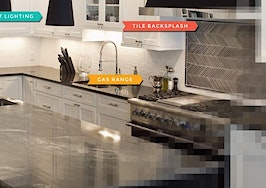- Computer vision technology teaches computers to view, dissect and understand images, and then automatically identify and tag features that would be attractive to a potential buyer.
- A number of real estate companies, such as RealScout and Zillow, are using the technology, and Trulia has developed a proprietary imaging processing system to better serve their consumers.
- Trulia uses computer technology in conjunction with big data to identify and tag features in listing photos, recommend listings and provide tailor-made content to users.
The human brain can fully process an image in 13 milliseconds and identify approximately 100 million colors, which is one of the reasons why sellers and agents alike still rely on and trust human appraisers more than online valuations, like Zillow’s Zestimates and Redfin Estimate.
But online valuations, listings and search tools are benefiting from computer vision, a quickly developing technology that mirrors the human brain’s knack for quickly and accurately processing images.
In March 2015, RealScout founder and CEO Andrew Flachner talked about his company’s use of computer vision, saying that buyers don’t measure “home” in square feet. Instead, they focus on other elements of a home, such as a spacious backyard for their child to play in or an open floor plan that can adapt to changing needs.
“Agents and brokers who effectively integrate these technologies will be able to better cater to their clients’ needs, and will naturally be in higher demand,” he said.
Make finding ‘home’ faster and easier
Around the same time, Trulia began its foray into computer vision by building a proprietary image recognition system that could tag a kitchen, bathroom or bedroom and recognize smaller objects, such as granite countertops, stainless steel appliances and hardwood floors.
Since then, Trulia has been teaching its computers to be smarter, faster and more accurate, all in the name of helping their users find the place they’ll call “home.”
“By investing in big data, and machine personalization technologies, we’re helping our consumers find their perfect home in an easier way,” said Trulia VP of Data Engineering Deep Varma.
Varma recounted his introduction into the world of homeownership and how tedious the process was.
“I still remember when I bought my first home, and it’s a cumbersome process,” he says. “Me and my wife, we had to go through this. We had to go through the different data to understand the neighborhood better — what does this neighborhood look like? Does it have good schools?”
It took him 11 months to buy his first home in 1999, and the time had shortened to 9 months by 2005. In 2010, when he bought his first investment property, it only took 6 months — half the time it took in 1999.
“What we know is that it takes consumers months to find their perfect home, and what we’re doing is, we are providing this data in a much more meaningful way,” Varma said.
“And by using the machine learning, our goal is to shorten this time frame. That’s what we stay focused on.”
Personalization is key
The foundation of Trulia’s computer vision system is the personalization platform, which taps into users’ unique preferences and search criteria to push them toward listings that fit their wants and needs.
The computer vision system helps Trulia find the exact home or homes that fit that particular user’s criteria by looking at the listing photos and identifying the content of those photos.
“They [the computers] can look into the photos, they can see the content of the photos, and they can say: ‘Ah, I’m looking at the photos of a kitchen, bedroom or bathroom,’ — and it can also talk about the fact this kitchen has granite countertops or this living room has hardwood flooring,” he says.

An example of Trulia’s collections feature.
From there, Trulia can combine the data gleaned from users and their computer vision technology to power their homepage and provide users with a set of “collections,” which are various listings with the same unique attributes.
Varma says Trulia provides collections for any number of attributes, such as homes with pools, remodeled kitchens or open floor plans.
Finally, the computer vision system even personalizes which listing photos are seen first based on which property image garners the most attention from users.

What a listing looks like after Trulia chooses the most attractive hero photo.
Staying engaged
Varma says buyers can be so specific that they miss out on listings that could actually be perfect for them, so Trulia created the recommender system, which pushes selected listings outside of users’ search criteria.
“Rather than have the consumer have a narrow focus on a specific neighborhood, this allows us to give more options to consumers so they can see what else is in the marketplace,” he said.

Trulia uses big data and computer vision to predict what homes a buyer will love.
The recommender system is based on search terms and actions during the collaborative searching process, which sends users listings based on what people like them are looking at.
For example, if a user is looking at the same listings in the same neighborhood as you, Trulia will look at the other person’s search criteria and send listings based on that. Varma says the recommender system has bolstered Trulia’s site traffic because users are consistently coming back to see new recommended properties.
Varma adds that Trulia’s click-through models helps it send more what of consumers want to see and less of what they don’t, which keeps buyers engaged and coming back for more.
Computer vision allows agents to ‘see’ like never before
Varma says photos tell a better story than written descriptions ever could and allow buyers to better determine what they want before even walking into an open house or reaching out to an agent for help — something that cuts the transaction time down greatly.
“You can write a description of a property, but the truth is that those images can tell a better story,” he said.
“Computer vision technology is going to keep on making the inroads to helping consumers understand better.”













